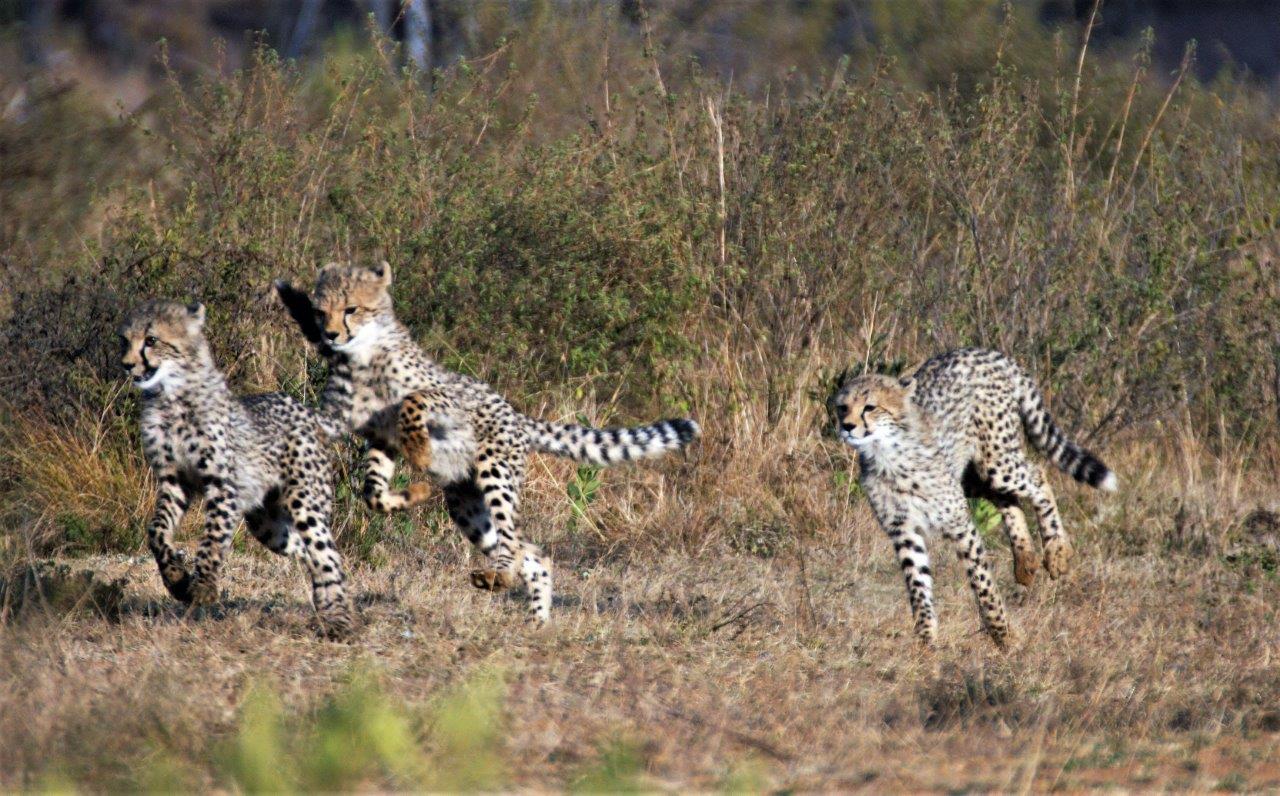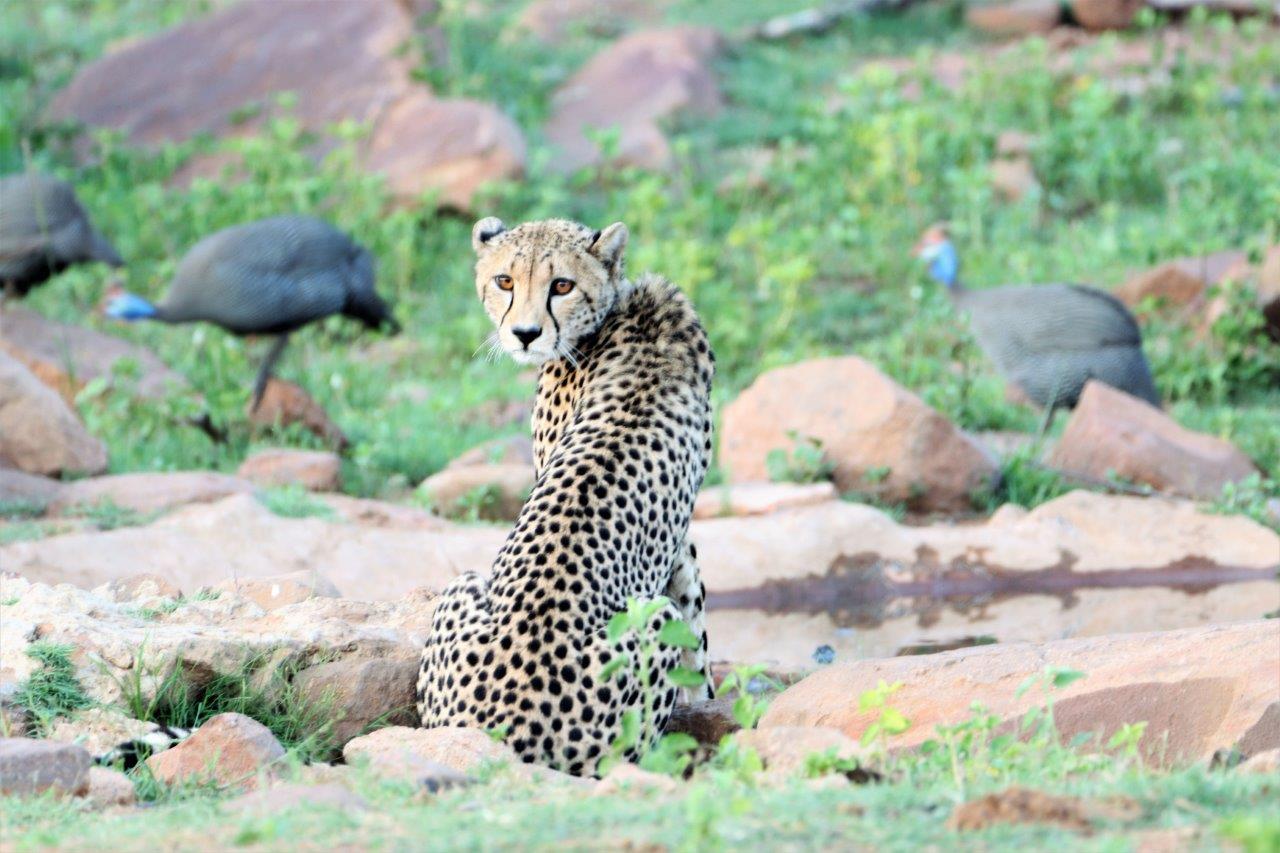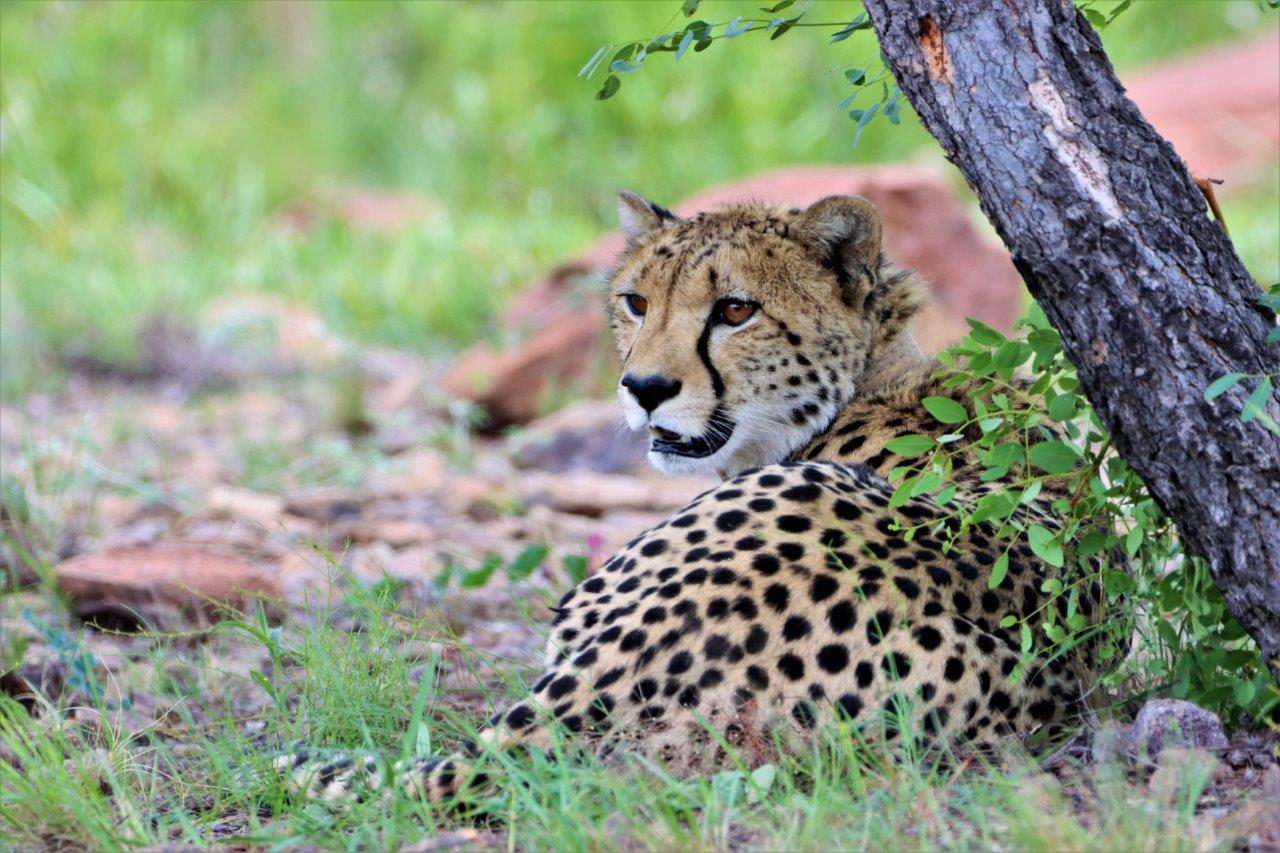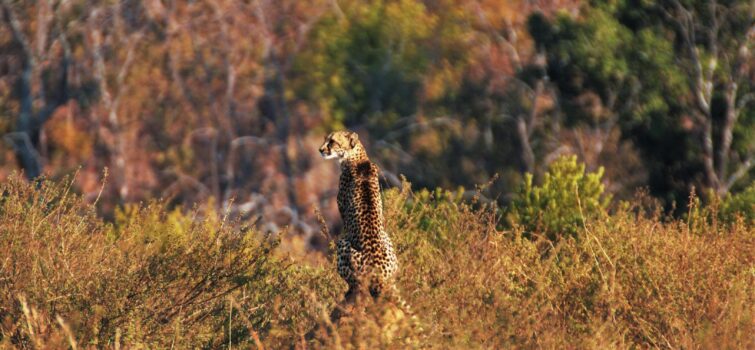You taught me almost everything…
But you didn’t teach me how to live without you.
A cloud may have a silver lining giving warmth and hope to us, but rarely does that silver lining have its very own silver lining, hidden within is symbolism of a better tomorrow.
Saturday, the 4th day of August 2018
It’s 8am and we are out on the morning game drive. Scanning the open grasslands adjacent to Fig Tree plains, we are rewarded for our patience and perseverance. A female Cheetah with her three, approximately six 6-month-old cubs, are spotted. Perched on a termite mound, Mom patiently surveying her surrounds for a potential family meal, her offspring gambling around in the shrubland, oblivious to what this day would hold for their futures. We watch them for some time, from a distance, as a group of Impala make their way slowly towards where the mother Cheetah has crept down low to avoid detection. Her cubs given the ‘shoosh’ signal as she prepares to provide for her family. In a flurry of grass, dust and speed her attempt is successful and we move in closer as the family begins to sit down to their Impala breakfast. We watch them a while, before moving on for the morning, making way for others to enjoy this intimate family time.
That afternoon drive did not reveal where the family had moved to rest and digest their meal from earlier in the day, and they were not seen or heard of.
The following morning drive, we looked for the family but without luck. Where we had seen them the morning before feeding on the Impala kill, we came across male Lion tracks. This would be a clear indicator that the family had moved on, avoiding any contact with the Lion, a very real threat to them all. We changed focus and followed the Male lion tracks away from the area. Although now late morning, fairly warm and our chances of finding him diminishing with every minute the sun rose higher, we continued our search without success.
After returning to the Lodge for a hearty breakfast, I later heard on the radio that the three young Cheetah had been found about five hundred meters from where we had seen them on the kill. They were near a little water crossing, waiting patiently under a wild fever tea for mom to return from a possible excursion to look for another meal.
That Sunday afternoon drive, we found the three youngsters, still patiently waiting for Mom to return. They would move to the little water crossing, drink water, and return to the little green bush that provided shade, some protection but mostly comfort for the three of them. This was to be their routine for the next three days. Mom would never return.
Whilst this adult female cheetah was never seen again, it is speculated that she had died at the hands of the male lion, whose tracks we had seen close to where the family enjoyed their last meal together. Interspecific competition between predators is common and provides the most real threat to all large African predators, particularly to their offspring.
On day three of being newly independent, too young and inexperienced to hunt and fend for themselves, the Welgevonden Reserve Management stepped in as decisions needed to be made.
It is never easy to make a choice, where so many emotions are involved. More questions than answers, no expertise to be drawn from and three little lives at stake. This would weigh heavily on anyone. The wildlife team were left with two choices. One, remove the three young cheetah from the Reserve and take them to a reputable wildlife rescue facility. This would give them a greater chance of survival, change their lives forever but they would be doomed to captivity, hardly a fair trade for the life they had begun. Two, give them a chance. Leave them wild and free to fend for themselves, with the odds neatly stacked against them to survive. Allow them the freedom to prove to everyone that these three siblings would be able to fend for themselves, living as wild cheetah as they should. The question remained which ultimately determined the final decision – Where was Mom? If she returned suddenly, perhaps from an injury or from losing her cubs in her attempts to lure the lion away from her cubs, then what? It would be highly unlikely that her cubs would re-unite with her if they were removed from the Reserve and later returned for her to resume her parental role. If she had died at the hands of the lion, well as devastating as this would be, it is natural and cannot be altered. In all inevitability, should mom return, it would be fair to give her cubs and her a second chance. As the Reserve is a conservation area with principles of management that follow a process of allowing nature to take its course as best as possible, the cubs should be given a fighting chance to fend for themselves and live freely as wild animals.
The decision was made.
They would stay and be given a chance to live freely. A radio telemetry collar would be fitted to one of the two sisters of the three youngsters, allowing the conservation team to monitor them and track their progress on the Reserve. From here on the three of them were affectionately known as the ‘Orphans’.

Thursday, the 9th day of August 2018
Six days after seeing mom for the last time, the three youngsters, by now starving, were offered a fresh impala carcass. They were sedated and the collar was fitted.
Friday, the 10th day August 2018
That morning drive revealed no signs of the Orphans. The carcass used to lure them to be sedated and collared, had been visited by the Male lion, suspect number one in the missing mom saga. His tracks were evident all around the devoured carcass, with no signs or indications of where the Orphans were. The conservation team started their tracking, using the telemetry collar to locate them. This however proved fruitless. A week past and still no sign of them. A second and third week past and still nothing. Almost five weeks after they were last seen, a signal from the collar was picked up almost 16 kilometres away, close to where they were born and where they had spent most of their early life with Mom. They had gone ‘home’.
The Orphans were born in the northwest of the Welgevonden Reserve, in the hills that surround Nyala plains. Abundant prey is often seen in the area and more importantly, the lions whose territory they share are seldomly seen in this area. The signal gave way to a finding of the Orphans. They were alive, hungry but well. They were offered an impala carcass, on which they fed ravenously and monitored for two days, before they disappeared again. From this encounter onwards, they were seen at intervals of two to three weeks and each time offered a meal for them to feed on and allowing the conservation team some time to monitor their condition and progress.
We encountered them from time to time on game drives and were well rewarded with time spent with them, watching them develop into sub adult and eventually adult cheetah. It was quite noticeable that the sister who was wearing the collar took on a leadership role, the minute she was honoured with wearing the tracking device. She wore it with pride and confidence and took her role seriously, almost indicating in her body language to her siblings that they should take note that she was chosen to don the collar that would become an important part of their journey into adulthood.

We remember the excitement we all shared when we watched them for the first time make their own kill. They would have killed for themselves before, but the first time we witnessed it was monumental and sent waves of admiration and respect for how they had faced such adversity and overcome it. The trophy impala lamb that they caught in front of us, would never know how significant it’s brief involvement in their development would be.
Losing a mentor, a care giver and your only connection to the life you would lead, so early on in their lives would have been devasting and to this day, we marvel at how this turned out and remain grateful for the conservation team’s decision and effort to witness this unfolding drama and giving the ‘Orphans’ a chance at a natural life. A silver lining like no other that would be the leading lining for one to follow.
Sometime in September 2019
One of the sisters and the brother of the Orphans are earmarked to be relocated from the Welgevonden Game Reserve to a Reserve in Malawi. This is in line with the reserves’ commitment to greater conservation efforts for wild Cheetah in Africa. The collared sister would remain on Welgevonden and allow her mothers legacy to be continued and her blood line to flow into future cheetah generations.
The International Union for the Conservation of Nature (IUCN) lists the Cheetah, Acinonyx jubatus, as ‘vulnerable’. With preference to habitats that are regarded as Savanna, Shrubland, Grassland and Desert, Cheetah once widespread in Africa and into parts of Asia, are dwindling, their numbers and ranges have considerably reduced and without careful intervention face certain extinction.
Cheetah, widespread in Africa, occur sparsely within their natural range. It is estimated that Cheetah have disappeared from 88% of their historical range. Current distribution fall within rangelands or farmlands with only 21% of the remaining population found within protected areas. Southern and East Africa are the last remaining strongholds of the current Cheetah population, with most countries having unknown Cheetah numbers and distribution, such as in Somalia and Mozambique. In parts of southern Africa, wild Cheetah occur largely in unprotected areas or ranch lands, where other large predators have been extirpated (Lion and Hyena). This is particularly the case in Botswana and Namibia.
In 2016 adult Cheetah numbers were estimated at being around 4216 with the largest population in southern Africa. 73% of these Cheetah occurred outside of Reserves or protected areas. Cheetahs live naturally in low densities, lower than lion or hyena, and are not social cats. In east Africa, research indicates that densities of Cheetah are around 1:100 km2. Seasonally however, this changes to up to as many as 40:100 km2. It was also found that Cheetah exist in low densities even where interspecific competition is low. They simply choose to live in isolation of each other, which makes management difficult and increasing numbers even more difficult.
The major threat to Cheetah conservation is habitat loss. Agriculture in Africa is a main contributor to habitat loss, but road and transport infrastructure plays it role. Hunting and trapping are other major threats.
Living in low densities, it is therefore necessary for large areas required for Cheetah to successfully survive. Large scale land management planning is therefor a focus for conservation groups, but most protected areas are too small to host large population numbers. This also leads to Cheetah being forced into areas with other large predators.
The Endangered Wildlife Trust (EWT) in South Africa is committed to addressing these challenges in effective Cheetah management. Solutions to the above challenges are recognised as being
- Range expansion, increasing the current range of wild Cheetah into other areas of the historical range of this species
- Habitat preservation, conserving those habitats more suited to Cheetah Conservation
- Creating connectivity, through facilitated dispersal of Cheetah between fragmented areas of Conservation
Welgevonden Game Reserve prescribes to this mantra and are committed to assisting the EWT better manage the meta-population of Cheetah in Africa and into Asia. By moving individuals off the Reserve to other protected areas, facilitating what would have been natural dispersal, the Reserve is ensuring that Cheetah genetics are managed across the meta-population and contribute to the overall success of Cheetah in countries where they once occurred but have been extirpated. Moving the two siblings of the Orphans, contributed to the greater Cheetah conservation efforts.
Friday, the 20th day of November 2020
Its 5am, we have woken the Guests for morning game drive. Preparing the coffee and tea snack box for the drive, I am interrupted by a group of Guineafowl alarming close to the Indaba, at the waterhole. I take a brief look and see what looks like a jackal at the waterhole. The Guests emerge and together we head onto the deck and are welcomed by the sight of a female cheetah drinking at the waterhole. It is the Orphan sister with the collar. We watch her drink, nervously looking around for any potential threats, under the close watch of the noisy Guineafowl. Having had enough of the feathered cacophony, she eventually moves off, into the treeline and hills behind the lodge. We look for her as we head out on drive, but she has gone, as quickly as she had emerged. Later during the morning drive, we decide to try and pick up on her again and head about 3km’s east of the camp, up the hills into the open plains area that lie above the Camp. We enjoy a coffee in the morning sun and try to pick up her tracks. Success, we find her hunting Impala on a small two-track road that runs parallel with the main road to Camp. We quietly and patiently wait for events to unfold, but as with many opportunities for her, the wind changes direction, and the group of Impala she is focused on catch her scent and are gone. She lies down under a small Burkea and allows us a brief opportunity to photograph her. Having not seen her for almost a year, she reminded me of her success story.

I will never forget the day we watched her mom scanning from her termite mound for a meal for the family, to the moment we all realised she was gone, and her youngsters were orphaned. We could never have imagined the fairy tale outcome that would result in a double silver lining. Giving the Orphans a chance to grow up as wild cheetah to adulthood AND contribute to the meta-population is inspiring and indicates the significance of conservation efforts in Africa.
Sadly, I learned 4 weeks ago that earlier this year the second sister of the Orphans was killed by a Leopard in her newfound conservation home in Malawi. The brother remains a healthy wild adult and will hopefully be father to a new generation of east African Cheetah, whilst his sister holds the fort back home in Welgevonden to raise her own families.
Cool Cheetah Fact!
Cheetahs are renowned for being the fastest mammal on earth, and deservedly so. They can reach speeds of just over 100kmph or 60mph! Their acceleration is exceptional. From standing still they move from 0 – 60mph (100kmph) in under three seconds. The fastest accelerating car in the world, the Porsche Spyder 918 is recorded at 2.2 seconds (according to manufacture specifications) for the same acceleration. It would be a close race.
Text – Neil Davison
Photographs – Neil Davison
References:
- 30 years of personal observations by the author on various Reserves in South Africa including Welgevonden Game Reserve
- 07.2019-Cheetahs-introduced-to-Majete-Wildlife-Reserve-after-decades-long-absence-final.pdf (ewt.org.za)
- Range Wide Conservation Program for Cheetah and African Wild Dogs (wordpress.com)
- revised-and-updated-southern-african-conservation-strategy-for-cheetah-and-african-wild-dogs_2015_english.pdf (wordpress.com)

